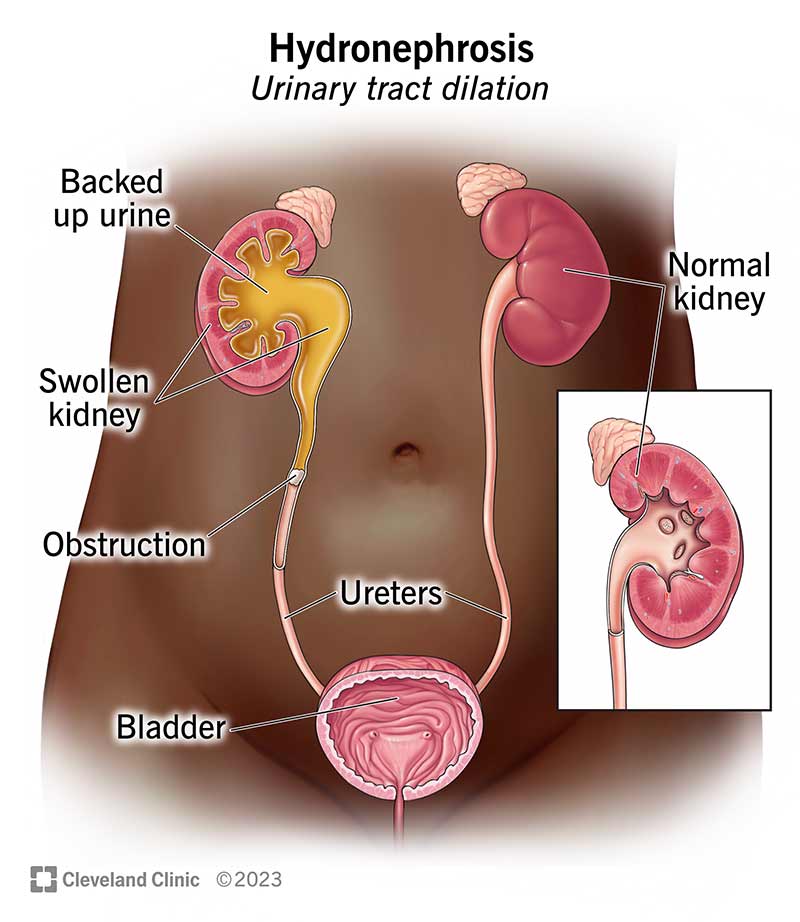Hydronephrosis is a condition of the urinary tract where one or both kidneys swell. This happens because pee (urine) doesn’t fully empty from your body. Symptoms may include sudden or intense pain in your back or side, vomiting, painful urination, blood in your pee, or weakness and fever due to a urinary tract infection. There are several approaches to treating the condition, depending on the underlying cause.
Advertisement
Cleveland Clinic is a non-profit academic medical center. Advertising on our site helps support our mission. We do not endorse non-Cleveland Clinic products or services. Policy

Hydronephrosis (upper urinary tract dilation) is a condition where something keeps pee (urine) from flowing from your kidney to your bladder. When that happens, one or both of your kidneys swell.
Advertisement
Cleveland Clinic is a non-profit academic medical center. Advertising on our site helps support our mission. We do not endorse non-Cleveland Clinic products or services. Policy
It can be sudden or chronic, partial or complete, one-sided or bilateral (both sides). If only one kidney is affected, the condition is called unilateral hydronephrosis. If both kidneys are affected, it’s called bilateral hydronephrosis. It can also vary in severity from mild swelling to severe swelling.
Hydronephrosis may lead to loss of kidney function or kidney failure. However, prompt treatment reduces the risk of long-term complications.
The main job of your urinary tract is to remove waste and fluid from your body. Your urinary tract consists of the following:
Often, a blockage or obstruction between your kidney and ureter is the cause of hydronephrosis.
Hydronephrosis can occur in people of all ages. It occurs in about 1 in 100 adults at some point in their life.
In infants, it’s often due to an obstruction (blockage) that happens during fetal development (antenatal hydronephrosis). This occurs in up to 1% of all pregnancies. It usually resolves on its own before birth.
Advertisement
Symptoms of hydronephrosis usually depend on the cause. Often, there aren’t any symptoms. Antenatal hydronephrosis in babies doesn’t usually cause symptoms after birth.
When symptoms occur, they can include:
Your chances of getting a UTI increase if you have hydronephrosis because pee is trapped in your body. This can lead to bacteria growing in your urinary tract. Symptoms of UTI include:
The most common cause of hydronephrosis is a blockage or obstruction in one of the parts of your urinary tract. Many conditions can cause this.
In adults, the conditions that most often cause hydronephrosis include:
In people with a uterus, hydronephrosis may occur as a result of:
In babies, antenatal hydronephrosis may occur due to:
Severe cases of hydronephrosis can damage your kidneys and lead to kidney failure. If this happens, you may need treatment with dialysis or a kidney transplant. Most people recover from hydronephrosis and don’t cause permanent damage to their kidneys.
Getting a diagnosis from your healthcare provider quickly is important because hydronephrosis can cause long-term kidney damage.
Your provider will diagnose hydronephrosis with:
Advertisement
A healthcare provider can detect hydronephrosis in a fetus as early as the first trimester on an ultrasound. It’s typically discovered during a 20-week ultrasound. A diagnosis at this time usually means the birth mother needs additional ultrasounds to monitor the fetus. However, most cases resolve on their own.
The goal of treatment is to restore the flow of pee from your kidney and decrease the swelling and pressure. Treatment depends on the underlying condition, as that is the primary issue.
Sometimes, mild cases resolve on their own without treatment. Other times, your provider may recommend a “wait and see” approach. Surgery is another option that your provider may consider. You should discuss all possible treatment options with your healthcare provider.
If hydronephrosis is sudden and due to a blockage, your provider may place a nephrostomy tube through your skin into your kidney to drain excess pee. They may also use a soft plastic tube called a ureteral stent to hold your ureters open, which allows your pee to flow as it should.
If stones in your kidneys or ureters are the cause, treatment options may include:
Advertisement
If you experience a UTI or your urinary tract is narrow due to infection, your provider will prescribe antibiotics to treat the infection.
Yes, it can become a serious issue without prompt treatment. However, most cases are mild to moderate and don’t cause serious health problems.
As an underlying condition causes hydronephrosis, prevention depends on avoiding or promptly treating that cause. Recognizing factors that put you at risk is also helpful in prevention.
Conditions that put you at risk for hydronephrosis are:
Try not to worry about a hydronephrosis diagnosis. In most cases, treatment will allow you to continue on with your life as usual without any long-term complications. Discuss any questions you have about hydronephrosis and your recovery with your healthcare provider. They can let you know if there are lifestyle modifications you should make or how long you can expect until a complete recovery.
Contact your provider if you have symptoms such as:
Advertisement
Hydronephrosis — a condition where your kidneys become swollen due to pee building up — can affect anyone. Luckily, getting a diagnosis and starting treatment can prevent complications from the condition. Talk to a healthcare provider if you have any unusual symptoms like pain in your side or abdomen, nausea or vomiting, and changes in how much or how often you pee. Your provider can discuss the many treatment options available for hydronephrosis after diagnosing the underlying cause.
If you have a condition that’s affecting your kidneys, you want experts by your side. At Cleveland Clinic, we’ll work with you to craft a personalized treatment plan.

Last reviewed on 08/25/2023.
Learn more about the Health Library and our editorial process.